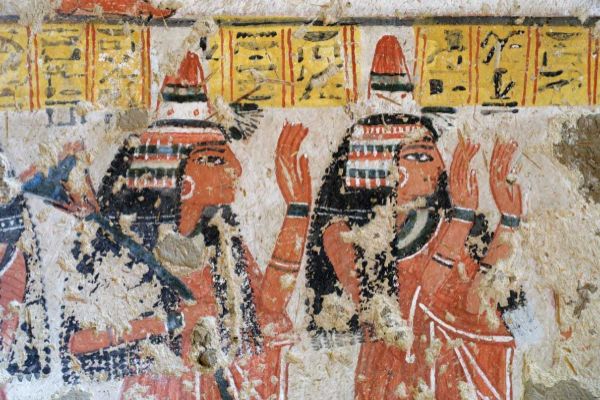- Luxor.The mystery of the tombs of two anonymous nobles of the Pharaonic Thebes
- Spanish finding. They have a funerary garden from 4,000 years ago
3,500 years ago two Pharaonic nobles built their eternal rest in one of the sacred hills of Thebes, the current Luxor, a stone's throw from the tombs of the monarchs they served. His abode had remained far from public scrutiny . A prolonged restoration now allows you to scan your bowels of colorful frescoes.
The Egyptian authorities, with the usual fanfare, have just presented two burials that are completing the map of graves that nest in the barren mound of Dra Abu el Naga, on the western shore of present-day Luxor, about 600 kilometers south of El Cairo
The first of the tombs belongs to Raya, Amón's fourth priest - the god of creation - and his wife Mutemwia was also buried inside her. The second, however, housed the rest of Niay, known as "scribe of the table" of offerings.
"Both tombs, the first of the nineteenth dynasty and the second of the twentieth, are about 3,500 years old and are in very good condition after these years of work, restoration, color arrangement and soot removal," he acknowledges Mustafa el Waziri, general secretary of the Supreme Council of Antiquities.
Next opening to the public
On the walls of the cavities, which will be open to the public soon, there are beautiful representations of the Book of Doors - a sacred text that recounts the journey that the spirit of the deceased must travel in the other world - and funeral and life scenes daily Despite the obvious traces of time and subsequent uses, the frescoes still retain the original tonalities.
Without funds or certain strategy to preserve the vast Pharaonic heritage scattered throughout the country, the Egyptian regime has relied on the medical examination and the cure of both graves at the American Research Center in Egypt. The US agency for international development has covered the mission with $ 2.14 million (1.9 million euros). An investment that has also allowed the tombs of wooden floors and enable a walkway for the access of tourists.
The hill of Dra Abu el Naga has become a real reef for the local and foreign archaeological missions that excavate the area. Last April a large tomb was discovered that belonged to Shedsu-Djehuty, a court master charged with watching over the funeral cones of the pharaoh. The burial, of 450 square meters, had up to 18 doors.
In 2017, an expedition of Egyptian archaeologists rescued in the same area the memory of Userhat, a nobleman from the New Kingdom who served more than three thousand years ago in the judicial halls of Thebes. A T-shaped tomb, like that of its neighbors, which begins with a large outdoor patio, enters the rock with a first rectangular room and runs into the burial chamber through a narrow corridor.
Planted on the road to the Valley of the Kings, Dr. Abu el Naga is also the moor where the Spanish project Djehuty is drilled, one of the most traditional expeditions of Spanish Egyptology. Two years ago the mission discovered the funerary garden built in front of a large tomb of the 12th dynasty. A succession of findings that shed light on the vastness and splendor of the Theban necropolis.
According to the criteria of The Trust Project
Know more- Science and Health
- science
TrafficThe elephant, against the ropes also for the legal sale of ivory
EnvironmentForest fires in Brazil increase by 83% due to deforestation and drought in the Amazon
Endangered species Two leopards of Arabia are born, one of the most endangered animals in the world

